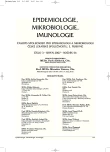Results of Surveillance of Human Leptospirosis
Výsledky surveillance humánnych leptospiróz, Slovensko 1986–2005
Cieľ štúdie:
Prezentácia výsledkov surveillance humánnych leptospiróz v SR v ostatných 20 rokoch.
Materiál:
Údaje sa čerpali z publikovaných každoročných výsledkov surveillance leptospiróz doplnené o vlastné poznatky zo sledovania prírodných ohnísk týchto nákaz.
Výsledky:
Analyzuje sa vývoj ako celkovej incidencie ochorení tak i podľa jednotlivých etiologických agensov, podiel jednotlivých typov leptospiróz, chorobnosť aj proporcionálny výskyt (%) jednotlivých typov ochorení podľa vekových skupín, výskyt podľa zamestnania resp. sociálnych skupín pacientov, sezónny výskyt, klinické formy ochorenia, opisujú sa niektoré uskutočnené epidemiologické opatrenia.
Koreluje sa intenzita epizootického procesu leptospiróz v ich prírodných ohniskách s výskytom ochorení u ľudí. Uvádzajú sa niektoré základné údaje získané pri surveillance leptospírových infekcií hospodárskych zvierat – prameňov nákazy humánnych infekcií.
Záver:
Zdôrazňuje sa zmysel a účelnosť vykonávania pravidelnej surveillance pri leptospirózach.
Kľúčové slová:
leptospirózy ľudí – surveillance – Slovensko 1986–2005.
Authors:
P. Bakoss; E. Macháčová; J. Jareková
Authors‘ workplace:
Univerzita Komenského, Lekárska fakulta, Ústav epidemiológie Bratislava
Published in:
Epidemiol. Mikrobiol. Imunol. 56, 2007, č. 3, s. 140-149
Overview
Study objective:
Presentation of results of surveillance of human leptospirosis over the last 20 years.
Material:
The data sources were the annually published results of leptospirosis surveillance and study of natural focuses of these infections.
Results:
We describe trends in the overall incidence of leptospirosis, distribution of cases by etiological agent and type of leptospirosis, morbidity rate, distribution of patients with different types of leptospirosis by age and occupation/socio-economic group, leptospirosis seasonality and clinical forms. Some epidemiological measures that were taken are specified.
Intensity of the epizootic process of leptospirosis in natural foci is correlated with the incidence of the disease in humans. Basic data from surveillance of leptospiral infections in farm animals as the source of infection for humans are presented.
Conclusion:
The significance and usefulness of conducting regular leptospirosis surveillance are emphasized.
Key words:
human leptospirosis – surveillance – Slovakia – 1986–2005.
Labels
Hygiene and epidemiology Medical virology Clinical microbiologyArticle was published in
Epidemiology, Microbiology, Immunology

2007 Issue 3
Most read in this issue
- Clinically Important β-Lactamases of Gram-Negative Bacteria: Extended-Spectrum β-Lactamases (ESBL)
- Prion Diseases
- Immunogenicity of Vaccines Against Viral Hepatitis A and B in the Population above 40 Years of Age – Impact of Risk Factors
- ABC Transporter Proteins in Multidrug Resistance of Microorganisms
